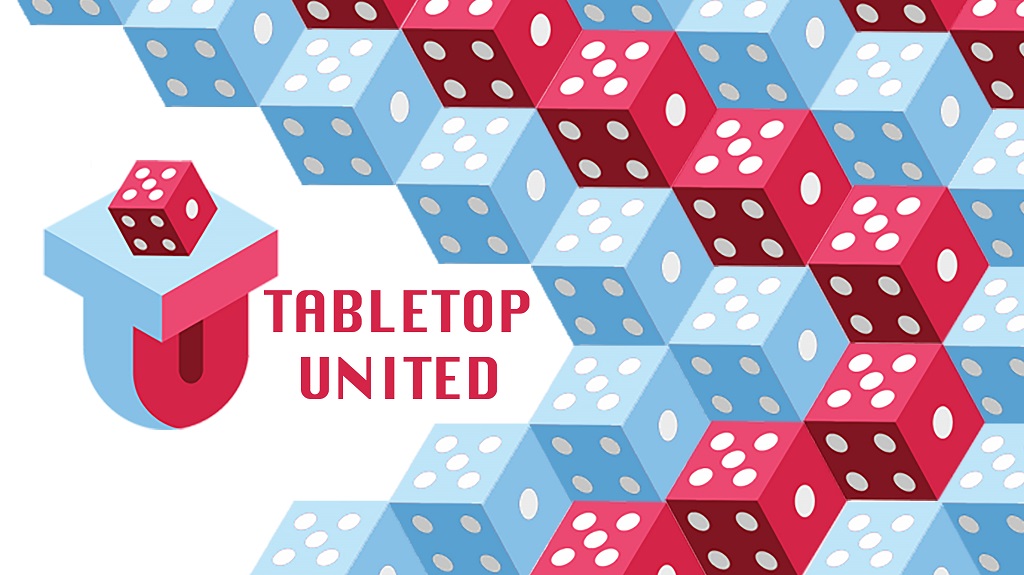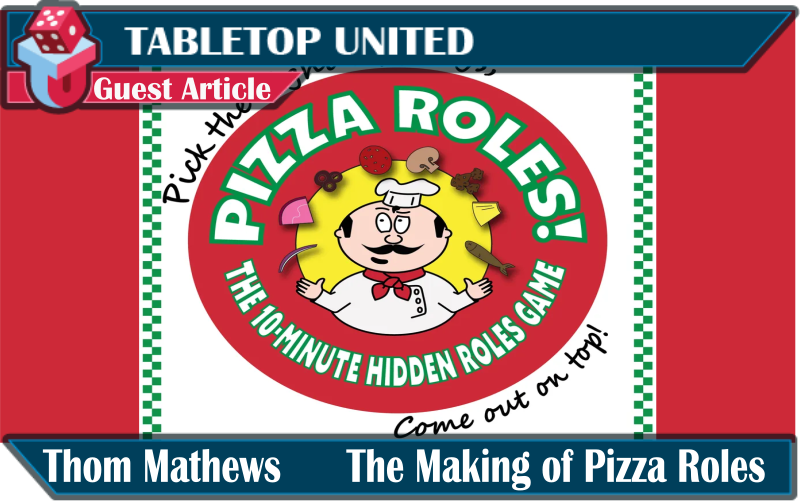Core Memories in Game Design:
The Making of Pizza Roles
by Thom Mathews
It’s 2016. I’m a 20-something hanging out at GenCon, enjoying the break from a less than stimulating job that I can’t quite convince myself to quit because health insurance is nice and this a very easy way to keep it. A friend and I pull out a new game in one of the free-play areas. It’s quick and simple. We roll some dice. My rolls are bad. I realize that the rules of this game are such that these poor rolls not only put me at a disadvantage, but they also cause most of my options to be functionally eliminated. I don’t really feel like I’m even playing. It feels unrecoverable after the first round, and my friend agrees. We don’t bother finishing.
“This game is … really bad,” I say. “How did this get published? I could make a better game than this…”
—
It’s 2017. I’m at my less than stimulating job, thinking about games. Thinking about that boast I made. Thinking, It’ll look like I’m still working if I jot some ideas down in Excel… What if low dice rolls weren’t bad, just differently useful….
—
It’s late 2017. I’ve fiddled around with an idea. It’s like Yahtzee with d4s through d20’s. I’ve even printed some scraps of paper that I slide into sleeves in front of Magic: the Gathering cards. A search of local meetups has led me to a group specifically for tabletop game designers. I work up the courage to show off a creative work to a bunch of strangers and then … winces internally … ask them for criticism.
They’re … really nice and supportive actually. One of them talks to me about his minor success in Kickstarter. I think, This guy doesn’t seem that different from me, and he’s got a successful Kickstarter. And I think I’m kinda good at this. I bet I could be ready for a Kickstarter in a year or two…
(I was not)
—
It’s late 2018. I’ve put a lot of time into the dice game, now titled “Game of Throws.” Game design has become a full fledged hobby, and I’ve found myself almost frantically putting together new designs, excited by this new world of creativity to explore. It feels incredible to create unique and dynamic experiences out of a few slips of paper and a couple of half finished ideas. I put together a map-based mechs-vs-kaiju game, a two-player deckbuilder, and a tile-based, not-quite-abstract city building game. The game design group meets monthly, and I find myself excited to show off a new idea each meeting. I also get a chance to see dozens of other unfinished games, and watch the journeys they make. Ultimately, most of them, including mine, end up abandoned and forgotten. Not necessarily because they’re bad (though some absolutely are), but because it’s simply too tedious to figure out why they don’t quite work when there’s always a new idea to explore instead.
—
It’s mid-2019. A friend visits from out of town, and we decide we’ll go out for lunch. A notable German restaurant is suggested, and nobody objects. As the Oompah band plays, we discuss what we’ve ordered, and my friend reveals his regret sheepishly, “Nothing looked good. I don’t really like German food…”
The rest of us voice our confusion.
“Well, nobody had their heart set on this place.”
“We could have gone anywhere.”
“Why didn’t you say something, if you knew you wouldn’t like the food?”
My friend had been too polite to say “no,” and not knowledgeable enough about the area to suggest anything else. He worried that we’d chosen the place with great intention, that he would crush somebody’s lunch-dreams by not acquiescing. Ultimately, we laugh it off and enjoy our meal well enough, but I am intrigued by this. How did a group of well meaning, intelligent, and compassionate adults come to a decision so poor?
The thought lingers in my mind. I’m fascinated by this real life communication glitch that seems like it should be easy to avoid, yet likely happens more than I even realize. After some internet searching, I learn I’m not the first person to think about this. There’s even a term for it: The Abilene Paradox—where a group of otherwise competent people can, through false assumptions and over-politeness, reach a decision that no individual actually wanted. It’s such a whimsical idea. There’s a game in here, somewhere…
—
It’s late 2019. I’ve just finished the first playtest of the tentatively titled “Pizza Peril” to … middling success. Each player gets a hidden goal card describing which toppings gain or lose them points, then simulates a conversation about ordering pizza by having players publicly draft toppings cards while asking for other players’ opinions. A voting phase follows where players can place an “Agree” or “Nah” card face down next to each ingredient. The voting phase is somewhat interesting, as players can’t tell whether lots of people are voting for or against any particular topping, but it’s slow and there’s little interaction. The math for tallying points is overcomplicated. It doesn’t work like I imagined. I take some notes and head back to the drawing board.
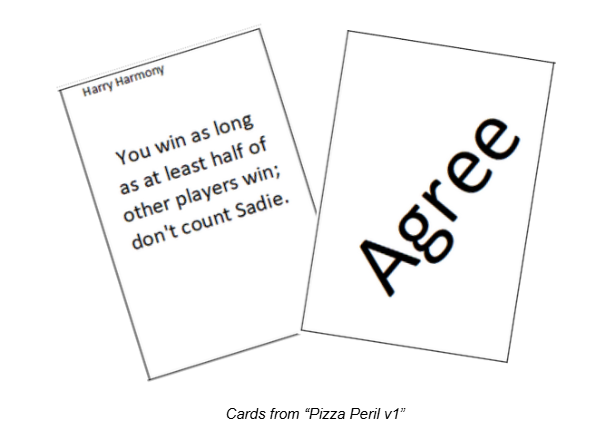
—
It’s early 2020. “Pizza Peril” has become “Pizza Roles.” The secret objectives have been simplified. Two topping cards have been removed. Play now simulates a conversation with cards called “How about …” and “I don’t know, ask ____” There’s also the “Social Anxiety” card that satisfyingly simulates the real thing; it sits in your hand doing nothing but taking up a slot that could have been something to let you add to the conversation. It’s simple, but entirely unfun. Players get a chuckle from the poorly enlarged clip art representing the toppings.
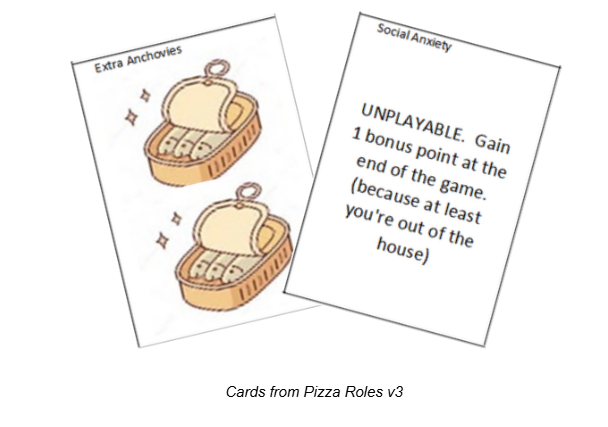
It could work eventually, but I’ve got other projects I like more. A revamp of the dice game. A vague idea about tesselating cards that create a map and pieces that fit into the gaps that are made. A dexterity game about blowing little toy sailboats with your breath (with the incredible title of “Thar She Blows”). But I’m most excited about my city-building game, now titled “OverTowered.” It plays great. The rules are so simple and elegant I can’t believe I’m the first one to come up with them. I talk with the folks at a maker space so I can use their CNC machine to make a really nice, 3-D prototype. I even buy the materials for it, hoping to get it assembled in the next couple of weeks.
—
It’s March 2020. Covid. Lockdowns. Plans are put on hold, and there’s no telling when that hold will end. I work from home full time. I have all the time in the world to design games … but no chances to actually play-test them. The materials I bought to create my fancy, 3-D prototype mock me from a shelf in the basement. The entire concept of “Thar She Blows” now seems downright scary. I create a flurry of new designs that go nowhere. Being unable to properly test things has turned my desire to create into frustration, and so I turn towards refining what I already have.
—
It’s fall of 2020. Pizza Roles gets some balance tweaks. A few new cards. A few cards taken out. Some point values on the hidden roles increased or decreased. My mother, desperate for human interaction in the middle of lockdowns, decides the family should get together for a canoe trip, since that’s an outdoor, “safe” activity. Of course, that means that when we’re not canoeing, there’s really not much else to do. We sit in our Airbnb and play a prototype of Pizza Roles that I thankfully thought to bring, and I witness something special. Not having kids of my own, I’ve had almost no chances to play-test anything with a child, so I’m excited to see my nephew, 10 at the time, totally enthralled by Pizza Roles. He revels in the power to take off the mushrooms his aunt just put on the pizza and the opportunity to feel devious as he reveals his secret role at the end of each game.
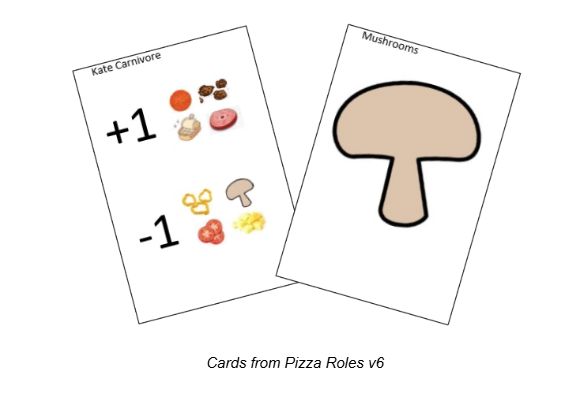
And the rest of us are also strangely hooked. We play the simple filler game that’s meant to kill ten minutes for a couple hours. It just feels nice to not only have a normal social interaction again, but also to simulate the normalcy of an imaginary one. For the first time, I truly believe Pizza Roles could be successful.
—
It’s late 2023. We’ve all spent a few years slowly returning to normalcy. I’ve heard from plenty of other designers how much effort their crowdfunding took, and also noticed that none of them have been excited to do a second one, even if they were successful. In an attempt to avoid a similar fate, I’ve dedicated some time towards pitching various games to publishers. I’ve gotten a few nibbles, but nothing ever materialized. I’ve gotten a lot more rejection, and an even greater number of no-replies. My sell sheets (résumés for a games) look embarrassing next to the others I see. I’m a game designer, not a graphic designer and certainly not a salesman. The pitch process is frustrating and disheartening. My games are fun! I want to share them! I inch slowly closer towards the siren song of crowdfunding.
I break out Pizza Roles again at another game design meetup. I’ve been ignoring it a lot since I’ve barely changed the design in years, but there’s some folks at this meetup that haven’t seen it yet.
As usual, everyone likes it. It is kinda tough to dislike. Everyone has had the conversation about ordering pizza before and felt the awkwardness of trying to balance their desires with the group’s. After a couple rounds of laughs, I put it away so we can try someone else’s creation. But later, as the night comes to a close, and we don’t quite have the time for another big game, someone says, “Can we just play Pizza Roles again?” There’s another few rounds of laughs as we play. We even play a couple games on the picnic table outside the restaurant after close. I make the decision that Pizza Roles is going to crowdfunding.
—
It’s late 2023. Pizza Roles has needed only a couple of minor tweaks, and I feel confident there are no more rules to update or pieces to add. Except one. Two-player mode. It’s been something I had initially discarded as impossible. The core gameplay fell apart with just two players; they either wanted polar opposite things and whoever had been dealt the better hand won or they wanted something similar enough that they found it quickly and the game felt predetermined. But an industry veteran had told me I needed to make it work. That putting “2-6 players” on the box was worth it.
I struggled with it for a few months, but eventually it led me to the convergence of two other ideas that various play-testers had suggested many times and I had always ignored.
“What about making more than one pizza?”
“What if players had to play cooperatively?”
I had thrown away each of these ideas a dozen times before. Multiple pizzas would remove the tension that happens when the players are pitted against each other, which was the core of the game. And players couldn’t play cooperatively because there are pairs of roles that are diametrically opposed—if one liked the pizza the other would by definition not like the pizza.
Each idea was fully nonfunctional by itself. But I suddenly realized that together, each idea cancels out the fatal flaw of the other. It couldn’t be that easy. There will be something I haven’t thought of that breaks the game, but I guess I’ll try it. I need to make two-player work…
At the next play-test night, I once again pull out Pizza Roles, explaining there’s something new I want to try out. I deal out the cards and explain the rules changes.
Cooperative mode works perfectly.
A couple players tell me, “Uh, I think I actually like this better than the normal rules.” …I think they might be right. The game changes from a cutthroat slugfest to a challenging puzzle of hidden information and teamwork, and the transformation is possible with an almost identical set of cards and rules!
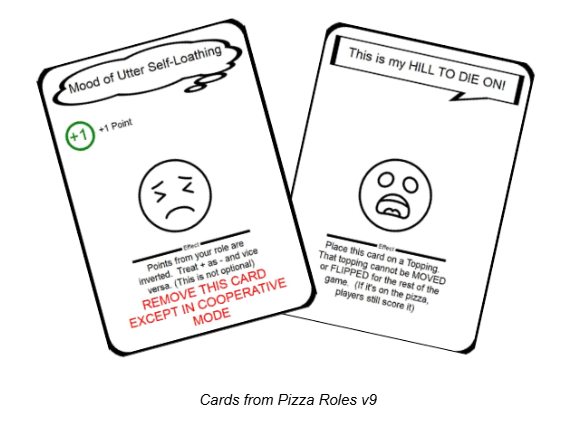
I’ve been designing games for years now. I’m one of the veterans of our game design group at this point, and I’ve just had my most polished design, a design I’ve worked on for years, both validated and completely upended at the same time. This is why I love this hobby.
—
It’s early 2025. I’ve spent over a year gearing up for the Kickstarter launch of Pizza Roles, which now happens next month. I’ve learned why my friends stopped after their first crowdfunding campaigns. I had to create a business, talk to accountants, learn graphic design, get quotes from manufacturers, order promo copies, budget, analyze, market, and spend hours and hours and hours demoing a simple filler game that’s designed to be played for 10 or 20 minutes at a time (it’s a testament to the quality of Pizza Roles that I can still find enjoyment in it at this point). Pizza Roles looks a real game.
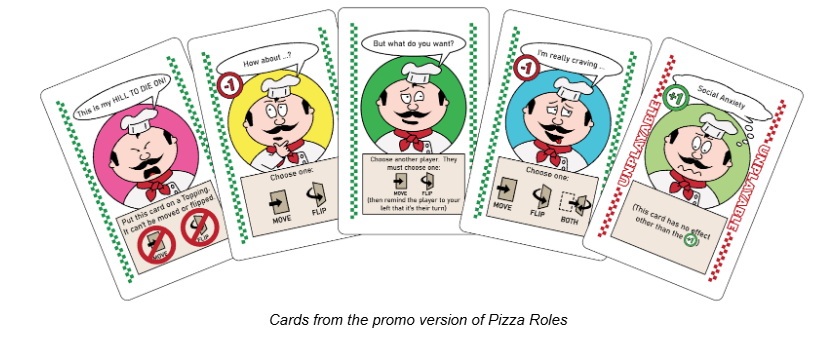
I’m exhausted and I’ve done too much procrastinating, so I reach out to a friend to help me design some advertising. He’s a graphic designer, so it should have been a no-brainer for me to ask him, but I’ve avoided it because I don’t have the budget to be paying him, and one of the few things I do know about the field is that graphic designers do not want to get paid “in exposure.” I don’t want him to feel like I’m taking advantage of our friendship for monetary gain. But, feeling desperate and running low on time, I ask anyway.
“Of course. I would be delighted to help. But… why didn’t you ask me before? This isn’t the first time you’ve needed graphic design for this project, right?”
I wanted his help, but I didn’t ask him because I worried he would think I was putting money over our friendship; that it might create some vague aura of quid pro quo between us.
He had wanted to help, but didn’t offer because he assumed I must not like his work and didn’t want to have that conversation.
We were both wrong. A real life communication glitch that should have been so easy to avoid. It’s the perfect poetic bookend for the design of Pizza Roles.
—
Thanks for reading! Pizza Roles launches on Kickstarter February 4th, 2025. You can back it here: https://www.kickstarter.com/projects/thomthegamedesigner/pizza-roles
